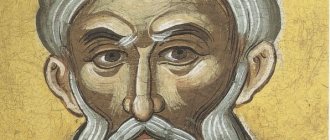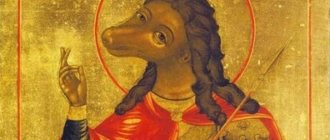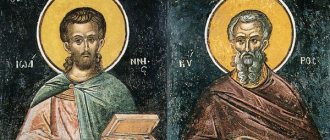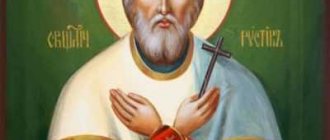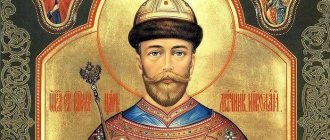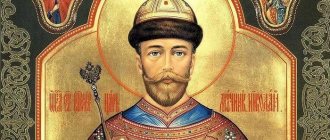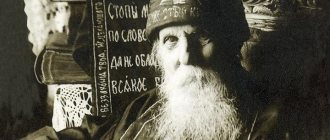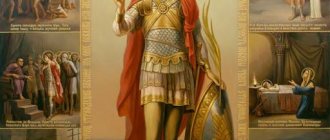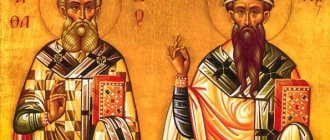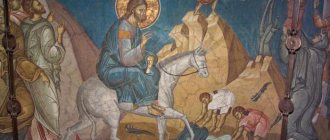Who are the Vyatichi
The Vyatichi tribe settled the territory of the upper reaches of the Oka River, occupied before them by the Baltic tribes of the Golyads (Golinds), quite late, only in the 8th century, when the rest of the Slavic tribes had long lived in Eastern Europe. According to the chronicler, they came “from the Poles” - from the territory located near the one that was occupied by the Poles, that is, from the west.
The name of the Vyatichi tribe comes, according to legend, from the name of their leader Vyatko (Vyacheslav, that is, “more glorious”). The Vyatichi gradually occupied a huge area of what is now Bryansk, Oryol, Kaluga, South Moscow, Tula, Voronezh, Lipetsk, and later Ryazan regions. The cities of Dedoslavl (the supposed capital of the Vyatichi - north of Tula), Bryansk, Karachev, Kozelsk, Sevsk, Krom, Mtsensk, Novosil, Yelets are founded here. At that time, in the center of this territory there was a gigantic “Okovsky forest”. According to anthropologists, the appearance of the Vyatichi people took shape at that time - they were tall people with tall, narrow faces and large noses.
Living in the forests, the Vyatichi preserved their pagan traditions for a long time. As the chronicler points out, foul language and polygamy flourished among them, with the kidnapping of brides by conspiracy at games between villages. They ate “everything unclean.” The dead were burned (there is evidence that his beloved wife could have been burned with the dead men) and buried in mounds, which were their temples, where they made sacrifices. We do not know for sure what kind of sacrifices these were, but according to the evidence of the chronicles and on the basis of archaeological research in Europe, it can be argued that bloody sacrifices of animals and even people were made everywhere.
Initially, the Vyatichi were subject to tribute by the Khazars, who professed Judaism, but chronicles indicate the Vyatichi as participants in the campaign of the Kyiv prince Oleg the Prophet in 907 against Byzantium. In 964, Svyatoslav the Great made an apparently unsuccessful campaign against the Vyatichi. But after the defeat of the Khazar Kaganate, in 966 he organized a new campaign against them. Perhaps, from this time on, the Kyiv princes considered the Vyatichi their subjects.
The future baptist of Rus', Prince Vladimir the Holy, back in 981, made a campaign against the rebellious Vyatichi, imposing tribute on them, and thereby nominally including their lands in Kievan Rus. But the chronicle states that the Vyatichi “got too much”, that is, they raised an army against the Kyiv governors and squads, and in 982 the prince pacified them again. In 988, according to the Tale of Bygone Years, the prince began to build cities on the Desna River and recruit “the best men,” including from the Vyatichi tribe, and populated the southern Russian cities with them. However, the chronicler does not mention Oka. There is no doubt that Vladimir baptized these “best,” that is, noble men. To this time, archaeologists attribute the appearance of the first Vyatichi mounds, where the remains were placed without burning, while the hands of the deceased were folded crosswise on the chest in a Christian manner. But alongside this were pagan amulets and rituals, which indicates the existence of pagan dual faith, when Christ was perceived and revered by local pagans as another pagan god. It remained dangerous to go seriously deep into the land of the Vyatichi, and they lived there according to the old pagan laws. This land was ruled by a local dynasty and remained generally unbaptized.
In 1024, after the victory of Prince Mstislav the Udal in the Battle of Listven, where he defeated Yaroslav the Wise, Chernigov was allocated from the Principality of Kyiv for Mstislav, which included the nominally subordinate lands of the Vyatichi.
Venerable Kuksha of Odessa: life, miracles, prayers
Exactly 20 years ago, on September 29, 1994, Metropolitan Agafangel of Odessa and Izmail discovered the relics of Elder Kuksha of Odessa, known throughout the Orthodox world. We bring to the attention of readers of the Pravoslavie.Ru portal a brief life of the Monk Kuksha, 10 stories of miracles he performed, as well as prayers and troparia dedicated to him.
Reverend Confessor Kuksha of Odessa
Schema-abbot Kuksha was born in 1874 in the village of Garbuzinka, Kherson province (now Nikolaev region) into the pious peasant family of Kirill and Kharitina Velichko. They had four children: Theodore, Cosmas (future father of Kuksha), John and Maria.
The saint's mother wanted to be a nun in her youth, but her parents blessed her for marriage. She prayed to God that one of her children would be worthy of asceticism in the monastic rite.
From a young age, Kosma loved silence and solitude and had great compassion for people. He had a cousin who was possessed by an evil spirit. Kosma went with him to an old man who was casting out demons. The elder healed the young man, and Cosme said: “Just because you brought him to me, the enemy will take revenge on you - you will be persecuted all your life.”
At the age of 20, Cosmas first went as a pilgrim to the Holy City of Jerusalem along with his fellow villagers, and on the way back he visited the Holy Mount Athos. Here the soul of the young man was kindled with the desire to serve God in angelic form. But first he returned home for his parents' blessing.
Arriving in Russia, Kosma visited the Kyiv wonderworker Jonah, known for his foresight. Blessing the young man, the elder touched his head with the cross and unexpectedly said: “I bless you to enter the monastery! You will live on Athos!”
Kirill Velichko did not immediately agree to let his son go to the monastery. And the priest’s mother, having received her husband’s permission, with great joy blessed her child with the Kazan Icon of the Mother of God, with which the saint did not part throughout his life, and which was placed in his coffin after his death.
So in 1896, Kosma arrived on Athos and entered the Russian St. Panteleimon Monastery as a novice.
A year later, the abbot blessed him and his mother to visit Jerusalem again. Here two miraculous events happened to Cosma, which served as signs of his future.
There is a Pool of Siloam in Jerusalem. There is a custom for all pilgrims, especially barren women, to immerse themselves in this source, and according to legend, the first one to be immersed in the water will have a child.
Kosmas and his mother also went to immerse themselves in the Pool of Siloam. It so happened that in the twilight of the vaults someone pushed him down the steps, and he unexpectedly fell first into the water, right in his clothes. The women cried out with regret that the young man was the first to plunge into the water. But this was a sign from above that Father Kuksha would have many spiritual children. He always said: “I have a thousand spiritual children.”
The second sign happened in Bethlehem. Having bowed to the birthplace of Christ the Infant of God, the pilgrims began to ask the guard to allow them to take holy oil from the lamps, but he turned out to be cruel and intractable. Suddenly one lamp miraculously overturned on Kosma, dousing his entire suit. People surrounded the young man and collected holy oil from him with their hands. Thus the Lord showed that through Father Kuksha many people would receive Divine grace.
A year after arriving from Jerusalem to Athos, he received the blessing to once again visit the Holy City and carry out obedience at the Holy Sepulcher.
Upon returning to Athos, on March 28, 1902, the novice Kosma was tonsured into the ryassophore with the name Constantine, and on March 23, 1905, into monasticism and named Xenophon. His spiritual father was the ascetic elder Melchizedek, who labored as a hermit and was a monk of high spiritual life.
In 1912–1913, due to unrest on Mount Athos, the Greek authorities demanded that many Russian monks, including the future saint, leave Athos. “God wants you to live in Russia; you also need to save people there,” said his spiritual father.
So the Athonite monk Xenophon turned out to be a resident of the Kiev Pechersk Lavra. Here on May 3, 1934 he was ordained a hieromonk.
Father really wanted to accept the great schema, but due to his youth his desire was denied. Once, while reveling the relics in the Far Caves, the monk prayed to the holy schema-monk Silouan to accept the schema. And at the age of 56, Father Xenophon unexpectedly fell seriously ill - as they thought, hopelessly. The dying man was tonsured into the great schema and given his name in honor of the holy martyr Kuksha of Pechersk. Soon after his tonsure, Father Kuksha began to get better, and then completely recovered.
These were years of severe persecution of the Orthodox Church. When the Lavra was affected by a wave of self-sacred schisms, Father Kuksha was an example for others in filial fidelity to the canons of the Mother Church.
One day, its former monk, Metropolitan Seraphim, arrived from Poltava to the Kiev Pechersk Lavra, wishing to visit his beloved monastery and say goodbye to it before his death. When Father Kuksha approached him for a blessing, the Metropolitan exclaimed: “Oh, elder, a place has been prepared for you in these caves long ago!”
In 1938, the priest began a difficult ten-year feat of confession. He, as a “clergyman,” was sentenced to five years in camps in the city of Vilva, Molotov region, and after serving this term, to five years in exile. So, at the age of 63, Father Kuksha was sent to grueling logging work. They worked 14 hours a day, receiving very meager and bad food.
At that time, Bishop Anthony lived in Kyiv, who knew Father Kuksha well and appreciated him for his virtues. One day, Vladyka, under the guise of crackers, was able to transfer 100 particles of dry Gifts to the camp to the monk, so that the priest would receive communion with them. But could he alone consume the Holy Gifts, when many priests, monks and nuns, imprisoned for many years, were deprived of this consolation?
Under great secrecy, they were all notified, and on the appointed day, prisoner-priests in stoles made from towels, on the way to work, unnoticed by the convoy, quickly absolved the monks and nuns from their sins and indicated where the pieces of the Holy Gifts were hidden. So one morning 100 people received communion in the camp. For many, this was the last Communion in their long-suffering life...
Another wonderful event happened to the priest in the camp. On Easter, Father Kuksha, weak and hungry, walked along the barbed wire, behind which the cooks carried baking sheets with pies for protection. Crows flew above them. The monk prayed: “Raven, raven, you fed the prophet Elijah in the desert, bring me a piece of pie too!” And suddenly I heard overhead “car-rr!” - and a meat pie fell at his feet. It was the raven who stole it from the cook's baking sheet. Father picked up the pie from the snow, thanked God with tears and satisfied his hunger.
In 1948, after the end of his imprisonment and exile, Father Kuksha returned to the Kiev Pechersk Lavra and was received with great joy by the brethren. Tempered in the crucible of suffering, the priest began to carry out the feat of eldership here, caring for many believers. For this, the KGB members ordered the spiritual authorities to transfer the elder from Kyiv somewhere far away, to a remote place.
In 1953, Father Kuksha was transferred to the Holy Dormition Pochaev Lavra. Here he was appointed to serve as a priest at the miraculous Pochaev Icon of the Most Holy Theotokos, and for three years he served the early liturgy in the Cave Church and confessed to people.
Venerable Amphilochius of Pochaev
One day, when he was standing at the miraculous icon of the Mother of God, a vein burst in his leg. The boot was full of blood. Hegumen Joseph, famous for his miraculous healings (in the schema of Amphilochius, now canonized), came to examine his sore leg. The diagnosis was disappointing: “Get ready, father, to go home,” that is, to die.
All the monks and laity fervently prayed with tears to the Mother of God for the granting of health to the dear and beloved elder. A week later, Abbot Joseph again came to Father Kuksha and, seeing the almost healed wound, exclaimed in amazement: “The spiritual children begged!”
The priest’s spiritual daughter said that once, during the celebration of the Divine Liturgy by Father Kuksha, she saw a splendid husband co-serving with him in the altar of the cave temple. When she reported this to Father Kuksha, he said that it was the Monk Job of Pochaev, who always serves with him, and strictly ordered not to reveal this secret to anyone until his death.
This is how the life of the elder proceeded in the Pochaev monastery, but the enemy of the human race began to persecute him here too, and in order to protect the priest from attacks from haters, Bishop Evmeniy of Chernovtsy in 1957 transferred him to the St. John the Theological Monastery in the village of Khreshchatyk, Chernivtsi diocese. The years of life here were quiet and calm for Kuksha’s father. But in 1960, nuns from the disbanded Chernivtsi convent were moved here.
After these events, Father Kuksha moved to the Odessa Holy Dormition Patriarchal Monastery, which became the last haven in his wanderings. Here the elder’s main obedience was confession. He received communion every day and was very fond of the early liturgy. He said: “The early liturgy is for ascetics, the late liturgy is for fasters.”
Many people remember how, during lunch, Father Kuksha picked up a small framed portrait of His Holiness Patriarch Alexy I standing on the table, kissed it and said: “We are drinking tea with His Holiness.” His words turned out to be prophetic.
When he came to Odessa to his dacha, Patriarch Alexy I always invited Father Kuksha to his place for a cup of tea, loved to talk with him, and was interested in what it was like on Mount Athos and in Jerusalem in the old days.
Saint Kuksha became the successor during the monastic tonsure of His Beatitude Metropolitan of Kyiv and All Ukraine Vladimir (Sabodan).
The priest said to his spiritual children: “The Mother of God wants to take me to her, but pray - and Kuksha will live 111 years! Otherwise, it’s 90 years and Kuksha is gone, they’ll take the spatulas and bury them.”
In the fall of 1964, he fell ill: in a fit of anger, cell attendant Nikolai kicked Father Kuksha out of his cell at 1 am in October. In the darkness, the elder fell into a hole, injuring his leg, and lay there until the morning, until the brethren discovered him. The elder fell ill with bilateral pneumonia. Despite the efforts of his loved ones, he never recovered from his illness.
The blessed ascetic foresaw the circumstances and time of his death. A few moments before his death, the elder said: “Time has passed” and very calmly departed to the Lord.
The authorities, fearing a large crowd of people, ordered not to accept telegrams from Odessa notifying about the death of Kuksha’s father, and demanded that the burial be carried out in his homeland. But the abbot of the monastery, admonished by God, wisely replied: “The monk’s homeland is a monastery.”
Burial place of the Venerable Confessor Kuksha of Odessa
After the blessed death of the elder, evidence of his holiness was the miracles performed at the grave of the saint, and on September 29, 1994, the ruling bishop, Metropolitan Agafangel of Odessa and Izmail, found the relics of the elder, and on October 22 of the same year he was glorified as a saint.
Even during his lifetime, Saint Kuksha bequeathed everyone to come to his grave with their sorrows, promising to intercede for everyone before God.
Today, the relics of the Monk Kuksha rest in the Odessa Holy Dormition Monastery, according to the behest of the saint, exuding gracious help to all who turn to him with faith.
MIRACLES OF REVEREND KUKSHY
Reverend Confessor Kuksha of Odessa
We bring to your attention a selection of ten short stories confirming the gracious help through prayers to the Monk Kuksha. The elder performed the first 5 miracles during his earthly life, the others through prayers to him after his blessed departure to the Lord.
Story 1. “If you make a vow to God to change your life and go to church, then your daughter will be healthy.”
One of the first miracles revealed by the Monk Kuksha occurred while still in prison. The Lord revealed to the elder that one of the guards at the house had a daughter who fell ill. “Child, take a vacation, go home, they will let you go. Your daughter is sick at home,” the saint admonished him. He didn’t believe that they could let him go: “They won’t let him go in the summer,” he said. The guard left, and the elder prayed for him and his sick daughter. Less than an hour later, he returned, saying that an urgent telegram had arrived, informing him that his daughter was very ill, and the authorities were letting him go home. “Pray, father, for her,” he asked, “after all, I have only one, her name is Anna.” The elder replied: “If you make a vow to God to change your life and go to church, then your daughter will be healthy.” He cried like a child and made a vow. Through the prayers of the monk, the girl received healing.
Story 2. 102-year-old disciple of the Monk Kuksha
In March 2014, at the St. John the Baptist Monastery in the city of Kungur, 102-year-old monk Nikon was tonsured into the great schema with the name of St. Kuksha of Odessa. During the Great Patriotic War, he served as a mortarman and was seriously wounded in the arm by a shrapnel, which was never removed. Over time, the fragment began to cause unbearable pain, and then Nikon went to his spiritual father. The Monk Kuksha suddenly sent him to cut down a dry linden tree for firewood. Exhausted from pain, Nikon went to cut down a tree for obedience. And after the first blows with an ax, the fragment suddenly jumped out of his hand, and the monk received healing.
Story 3. “The cell is full of demons, and everyone is running in a crowd through the door!!!”
One young novice, not understanding why the priest sprinkles his cell with holy water every evening, once asked him: “Father, why do you need to sprinkle it? What does it give? Three days have passed. Father Kuksha went to the novice’s cell and, before his eyes, began to sprinkle it with holy water. Subsequently, the monk said: “And suddenly I saw this, I saw this! The cell is full of demons, and everyone is running in a crowd through the door, but they don’t have time, they fall out one after the other...” Having sprinkled the cell, the elder asked: “Well, have you seen what it gives?”
Story 4. The power of alms
The elder attached great importance to almsgiving. His spiritual daughter asked someone for a book with an akathist and wanted to copy it for herself. In the temple, she placed the little book near the candle box, where her friend monk Thaddeus sold candles, and she herself went to be anointed with oil. When she returned, she discovered that the book was missing. The woman began to grieve, because the book was someone else’s, and with her misfortune she turned to Father Kuksha. “Don’t grieve, ask the Lord to accept this as alms. But the enemy doesn’t like alms, he will return everything, he will return everything,” was the priest’s answer. The next day in the evening the book lay in the same place where it had been placed. Father Thaddeus said: “So, people brought it and said that they found this book on the tram. They didn’t know what to do, they thought and thought and decided to take him to a monastery. They came to the monastery and laid her in the very place where she was.”
Story 5. Hint for the scientist
Once a famous scientist came to the monk, who had some unsolvable problem in his scientific work. In a conversation with him, Father Kuksha, with his simple words, led him to think about the correct solution to the issue. The scientist, leaving his cell, told in joyful amazement how the unlearned elder helped him discover the secret of his scientific research.
Story 6. “Be patient and pray, your husband will be a Christian!”
His spiritual daughter Elena often came to see the elder. She was a scientific chemist, and her husband was a mining engineer, a major specialist in rocks. She was very sad that her husband was not baptized and even wanted to separate from him, but the elder told her: “Be patient and pray, your husband will be a Christian!” After the death of the elder, she went to the Pskov-Pechersk monastery and persuaded her husband to take her there. In the Pechersky Monastery there are caves created by God where deceased monks are buried. Elena invited her husband to look at the coffins, which, according to custom, are not buried here, but placed one on top of the other in caves in which the grace of God is clearly felt. When Elena’s husband saw the vaults of the caves, he, as a mining engineer, was amazed that the loose sandstone had not crumbled for centuries, held together like stone, and collapses did not occur. Such an obvious miracle made a strong impression on him. The grace of God touched his heart. He wished to be baptized immediately, and then married his wife and, like a child, was devoted to God and his spiritual father.
Story 7. “Suddenly I saw the Monk Kuksha, who, approaching, put his hand on my forehead...”
A student of the Odessa Theological Seminary, Alexander fell ill with severe pneumonia. The temperature rose to 39.9 degrees. Both the seminary medical assistant and those living in the room with him were worried about him. On the night of December 12, 1994, when Alexander fell into oblivion, they called an ambulance. The patient, being unconscious, called out loudly the name of the Monk Kuksha. Suddenly he fell silent and seemed lifeless for a while. Frightened by this, his friends began to shake him, calling him by name. Suddenly Alexander came to his senses and got out of bed. To everyone's surprise, he looked completely healthy. We took the temperature and the thermometer showed 36.6°. Then he was asked about such a sudden change in condition. Alexander said that when it was extremely difficult for him and there was a feeling that life was leaving him, he saw the Monk Kuksha, who, approaching, put his hand on his forehead. Suddenly he felt a strong surge of blessed power, which passed three times from head to toe. Then he felt that someone was shaking him and calling his name. When he woke up, he felt healed. Doctors who arrived soon found him healthy.
Reliquary with the relics of the Venerable Confessor Kuksha of Odessa
History 8. The woman did not know that during his lifetime Saint Kuksha also suffered from a leg disease.
One woman, seriously suffering from a leg disease - thrombophlebitis, came from Moscow to the Holy Dormition Odessa Monastery to pray to the Venerable Kuksha. Her legs ached seriously, her veins were swollen, and she, completely exhausted, fell to the shrine with the holy relics and whispered: “Reverend Father Kuksho, help!” And only in Moscow, getting off the train onto the platform and running towards her son, did she realize that she was healed: the tumor had disappeared, the veins had become normal, the pain had gone away. At that time, this woman did not yet know the life of the Monk Kuksha, who during his lifetime also suffered from a leg disease.
In the spring of 1996, a singer of the St. Nicholas Church in the city of Pushkino, Moscow Region, learned the story of this healing. A few days after hearing what she heard, a neighbor came to her in terrible grief: her husband had gangrene in his legs, amputation was inevitable. The singer told her about the Monk Kuksha and his special mercy to those suffering from leg disease. A prayer service to the monk was immediately served in the church. In the meantime, the patient was transported to Moscow for surgery. Everything was ready for amputation, but doctors noticed that blood circulation began to be restored. “A miracle saved you,” this is what the doctors told the patient, who, of course, knew nothing about the prayer service served or about the ambulance and miracle worker Reverend Kuksha.
Story 9. Miracle of healing of a sick child
A few days after the glorification of the Monk Kuksha, one servant of God shared her joy. Her child was sick; he had a very high fever for several days, and the parents no longer knew how to help him. This woman was at the glorification of the saint and received pieces of vestments and a coffin. At home she was met with reproaches that the child was sick and the mother was not there. She immediately went to her son and, after praying, placed pieces of the vestment and coffin on his head. The child fell asleep and woke up the next day completely healthy.
Story 10. Resurrection of a dead girl
Through the prayerful intercession of the Monk Kuksha, the Lord raised the baby from the dead. In Odessa, in one Orthodox family, on the night of January 7-8, 1996, two-year-old Ksenia suddenly fell ill. The temperature rose sharply above 39 degrees and continued to rise. The girl began to rush about in the heat. Ksenia’s grandmother, a doctor by profession, seeing her extremely serious condition, asked her daughter, the girl’s mother, to call an ambulance. While she was talking on the phone, Ksenia suddenly became quiet. The grandmother began to examine her granddaughter: her heart was not beating - life had left the girl. “There’s no need for an ambulance, it’s too late...” she told her daughter. In despair, the child’s mother knelt in front of the icons and began to tearfully pray: “Lord, take my soul, and leave her soul!” After a long prayer, she remembered that in the fall of 1994, at the Holy Dormition Monastery in Odessa, she was given pieces of the vestments and coffin of the Monk Kuksha. Calling on the name of the saint, the mother took these particles and applied them to the forehead of the deceased girl. Suddenly Ksenia took a deep breath - life returned to her. When the girl finally came to her senses, she pointed to the icon of the monk and asked her mother: “Give me Kuksha...”. The arriving doctor, after examining the girl, said that he did not find any reason to call an ambulance. The family calls this day Ksenia’s second birthday.
PRAYER AND TROPARIA
Reverend Confessor Kuksha of Odessa
Prayer
About the reverend and God-bearing Father Kuksha, praise to the monastery of the Dormition of the Mother of God, unfading color of the God-saved city of Odessa, meek shepherd of Christ and great prayer book for us, we earnestly resort to you and with a contrite heart we ask: do not remove your cover from our monastery , in which you fought a good fight. Be a good helper to all who live piously and work well in it. O our good shepherd and God-wise mentor, Rev. Father Kuksho, look mercifully at the people ahead, tenderly praying and asking you for help and intercession.
Remember all those who have faith and love for you, who prayerfully call on your name and who come to venerate the relics of your saints, and mercifully fulfill all their good requests, overshadowing them with your patristic blessing. Deliver, holy father, from every slander of the enemy our holy Church, this city, monastery and land, and do not leave us weak, burdened with sins and sorrows through your intercession.
Illuminate, O most blessed one, our mind with the light of God’s face, strengthen our life with the grace of the Lord, so that, having been established in the Law of Christ, we may flow unlaxly along the path of the holy commandments. Bless us with your blessings and grant us all those who are in sorrow, those who are overcome by mental and physical illnesses, and grant healing, consolation and deliverance. Over all of these, ask us from above for the spirit of meekness and humility, the spirit of patience and repentance, for those who have departed from the Orthodox faith and are blinded by destructive heresies and schisms, for enlightenment in the darkness of unbelief with the wandering light of the true knowledge of God, for discord and discord, quenching, implore the Lord God and the Most Holy Theotokos grant us a quiet and sinless life.
Remember us, unworthy, at the throne of the Almighty, ask for a peaceful Christian death and grant us, with your help, eternal salvation and inherit the Kingdom of Heaven, and let us glorify the great generosity and ineffable mercies of the Father and the Son and the Holy Spirit, in the Trinity of the worshiped God, and your paternal intercession in forever and ever. Amen.
Troparion, tone 4:
From your youth you left the world of wisdom and the evil one, having been enlightened by divine grace from above, reverend, with much patience in your temporary life you accomplished the feat, thereby exuding miracles of grace to all who come with faith to the race of your relics, our blessed Father Kuksho.
Kontakion, tone 8:
The skilled ascetic of piety, the new confessor of the faith of the fathers, the Reverend Kuksha, we will surely please everyone, as a true shepherd, a gracious elder, a mentor of monks, a comforter of the faint-hearted, a healer of the sick, and at the end of his life showing the lordship of his life. And today we come to his memory and cry out joyfully: for having boldness towards God, deliver us from manifold circumstances, so that we call to you: Rejoice, affirmation of Orthodox people.
History of Baptism
The baptism of the Oryol region and the entire land of the Vyatichi is associated with the name of the Kyiv prince Vladimir Vsevolodovich Monomakh (1053-1125). His father, the son of Yaroslav the Wise, Vsevolod Yaroslavich (1030-1093), after the death of Yaroslav, inherited the Pereyaslavl throne. Vladimir, as he himself tells in his teaching to children, became acquainted with our region at the age of 13, when for the first time, on behalf of his father, in about 1066, he made his first trip to the city of Rostov the Great, which belonged to Prince Vsevolod, through the land of the rebellious Vyatichi. He was apparently proud of this until the end of his days, and he begins his autobiography with a description of this event.
In 1077, Vsevolod became the prince of Chernigov, but the following year he ascended the capital throne of Kiev, and Chernigov passed to his son Vladimir. Since the Vyatichi tribes were formally part of the Chernigov principality and had not yet been fully baptized, the task of introducing them to Christianity became one of the main concerns of the new prince. However, before this, the inhabitants of these lands had to be brought to submission.
Presumably in 1092-1093, Vladimir made two winter campaigns in the lands of the Vyatichi. In winter, they were carried out because among the roads through these territories, only one direct road is mentioned - the one on which Saint Ilya Muromets fought with the robber Solovy Budimirovich. Therefore, the army was forced to walk along frozen rivers. First, fighting with Prince Khodota near his city of Kordno, and apparently having killed him, in the second winter Vladimir entered into battle with his son, whose name he does not name. In April 1093, the Great Prince of Kiev Vsevolod died, and in 1094 Vladimir ceded Chernigov and passed to the Pereyaslavl throne.
Having lost their political independence, the lands of the Vyatichi after the Lyubech Congress and the Treaty of 1097 finally became part of the Seversky and Ryazan appanages of the Chernigov principality. The lands along the Desna and Oka went to the first, and the entire course of the Sosna River went to the second. Later, three independent principalities were formed from it: Chernigov, Novgorod-Seversky and Murom. According to this division, the land of the Vyatichi goes to the Novgorod-Seversky principality. However, in church terms they were under the control of the Chernigov See, which could take upon itself the spread of Christianity among the Vyatichi.
When in April 1113, after a solar eclipse that frightened the people of Kiev, the Grand Duke of Kiev Svyatopolk Izyaslavich, who robbed monks and patronized moneylenders, died, and an uprising broke out in Kyiv, the people called Vladimir Monomakh to reign. Thus, the Monomashich dynasty was finally established in Rus', ruling it for another 500 years.
Undoubtedly, at the insistence of the Grand Duke, who knew the land of the Vyatichi well and with the blessing of the Kyiv Metropolitan, already in the summer of the same 1113, a Christian mission headed by Kuksha and his disciple Nikon was sent to the Vyatichi region. Some historians believed that, fearing uprisings and wanting to remove the captured Prince Kuksha, possibly the son of Khodota, from hereditary power, Vladimir Monomakh took him to Kiev, converted him to Christianity and tonsured him as a monk, depriving the Vyatichi of their hereditary leader. According to another version, Kuksha came from among the “best men” baptized by Saint Vladimir, among whom Christianity continued to develop, and this may explain the vague legends about his nobility. At his tonsure, according to legend, he received the name John. However, there is no reliable information about this, since the Church canonized him under the name that he received in paganism. Many historians also saw this as evidence of his nobility. The custom, in addition to a Christian name, to also have a folk name, persisted for a long time in our region after the adoption of Christianity. Even under Tsar Mikhail Fedorovich, the following names are mentioned in the Bolkhov census books: “Bear Nechaev, son of Kishaev”, “Neustroy Ivanov, son of Belenikhin”, etc.
The name Kuksha, which was brought to us by the Kiev-Pechersk Patericon, is clearly pagan in origin. There are several versions of its meaning. In northern Russian regions, this word means a bird of the raven family. Another explanation for the meaning of the name follows from the ancient root “kuk”, meaning dryness (you can compare the words skuksitsya - shrivel up, or shukozhitsya - shrivel up). An extensive list of geographical names of the Oryol province of the early 20th century with this root convinces us that Saint Kuksha could have come from the lands of the Vyatichi. In an early version of the Kiev-Pechersk Patericon, the saint is also mentioned as Kupsha, which is an abbreviation for the name Kipriyan (Kuprian). At the same time, the sources refer to this time as mentioning the Kiev Kupsha Monastery on the Setoml River. In this case, Kupsha is possibly the second monastic name of the same person, probably even the founder and abbot of the monastery.
Kiev-Pechersk Lavra. Fragment of an icon, 21st century.
It is reliably known that the Hieromartyr Kuksha was a monk of the Kiev-Pechersk Monastery. One of the main forms of activity of the monastery was the apostolic mission in the lands of the pagans. The Kiev-Pechersk Lavra, from where the mission was carried out, was closely connected with the Chernigov department. Probably, Kuksha was called to preach the Gospel among the Vyatichi by the Chernigov Archbishop John, who draws attention to the spiritual state of the Vyatichi. Obviously, the mission consisted of several people, otherwise it would have been impossible to sail such distances and overcome the jungles of forests and swamps on river boats.
In 1113, Archbishop John was replaced by Saint Theoktist, former abbot of the Kiev Pechersk Monastery (from 1103 to 1113), whose closest associate was Kuksha (iv). Apparently, the missionaries set off from Chernigov along the Desna River. Having passed Novgorod-Seversky and Trubchevsk, inhabited by northerner tribes, the mission reached the Vyatichi borders near Bryansk.
In the western districts of the Oryol province, an ancient legend about the “great man” Kuk was recorded. Forests and mountains opened up before him. He moved rivers and lakes.
This was followed by a transition to Karachev, after which the monks entered the pagan lands through impenetrable wilds and swamps. Having reached the Oka, they went along it to Mtsensk. Here the Monk Abraham of Pechersk separated from the mission and preached in the land of Novosilsk.
According to legend, Saint Kuksha, in the Mtsensk Church of the Presentation, a small wooden church cut from huge oak trees that grew nearby, erected a miraculous image of St. Nicholas made of wood in human height and an eight-pointed stone cross. In 1238, when Batu Khan went to Mtsensk, the priests hid him at the foot of Mount Samorod in a hidden underground passage, near a hidden spring. It was found only in the year of the final victory of Christianity in Mtsensk in 1415. There is an assumption that the Church of the Presentation marked the beginning of monasticism in this city.
Kuksha's preaching was accompanied by miracles. He “healed the sick and through miracles brought many to Christ.” In the Pechersk Patericon, where the life of the saint is located, we read that Kuksha’s contemporary, Bishop of Vladimir Reverend Simon (Simeon) (1214-1226) in a letter to Blessed Polycarp, later Archimandrite of the Kiev-Pechersk Monastery, wrote about Kuksha:
“Zane Vyatichi and people darkened by unbelief, baptize and enlighten many with faith. Work many and great miracles. He drove away the demons, “bringing down the rain from heaven, drying up the lake.”
Indeed, among the deified elements was water, personified in the image of Kupala, and all lakes and rivers, according to the ideas of our ancestors, were filled with lower deities who bore the general name “water ones.” They drowned living people in them as sacrifices, tying stones to their feet. Thus, the lake dried up by Saint Kuksha had a religious character for the Vyatichi.
The pagans began to be baptized. But further in the Kiev-Pechersk Patericon we read that the saint “after many torments was beheaded with his disciple Nikon.” Since Saint Simon does not call Nikon a holy martyr, it follows that he did not have holy orders, but was a novice or cell attendant of Kuksha.
According to legend, for prayer Kuksha, 12 kilometers from Mtsensk, in the direction of Bolkhov, near the right bank of the Oka, in the forest on a slope 1.5-2 versts from the village of Karandakovo, built a hermitage house, and nearby he dug “Bogomolny” or “ suffering saint" well. At the beginning of the 20th century, local residents said that “Kuksha lived in these places,” and he shed blood half a mile from the wells in the forest along a large road near a swamp, the banks of which gradually narrowed. Apparently, on an August night, the pagans attacked the missionary camp, subjected the monks to torture, and then Saint Kuksha was taken aside and beheaded by the swamp - with a sword “he and his disciple were beheaded.”
His spiritual brother, the ascetic of the Pechersk Monastery, blessed Pimen the Faster, saw through the martyrdom of the saint. He “cry out loudly in the middle of the Pechersk church: our brother Kuksha has been killed on this day against the light” and he himself reposed (6). “Against the light” - most likely, we must understand that he suffered a martyr’s death at dawn on August 27 (September 9), 1113. Historians of the past believed that the killers of the monk were the priests of the Vyatichi or their elders.
Kyiv monks sent people to the country of the Vyatichi to search for the bodies of missionaries. They took away only the relics of the first baptist, which were placed in the nearby (Antonian) caves of the Lavra, where they are still located today. There was a belief that the relics of Kuksha’s student Nikon would be revealed in the village of Grigorovo (now Bolkhovsky district).
Murder of the Monk Kuksha. Fragment of an icon, 21st century.
Already five years after Kuksha’s death, clear traces of Christianity can be found in the cities of the region. Thus, near Krom, in 1147, a peace treaty between Svyatoslav Olgovich and his Chernigov relatives was signed and approved by kissing the cross of prominent Vyatichi (7). Bishops Porfiry I and Porfiry II on their way to Vladimir passed through the Mtsensk region more than once.
Archaeological finds also indicate that already at the end of the 13th century, pots with ritual pagan funeral food - offerings to the pagan gods - disappeared from Vyatichi burials. Archaeologists have found stone crosses dating back to this time.
Apparently, the memory of Kuksha was maintained at first. Saint Simon wrote that in his time the saint was known and revered by everyone. According to the peasants of the 19th century, the well where the enlightener was killed was a “holy place” and pilgrimage near it “has taken place since time immemorial.” According to legend, near the swamp at the site of the death of Saint Kuksha over the “Praying” or “suffering holy” well, his admirers built a chapel with a cross, where local residents annually on the second day of the Trinity holiday gathered for a prayer service in front of icons from the parish church in the village of Telche. On the road opposite the well there was a cross with a built-in mug for collecting donations. However, over time, veneration began to weaken. By the end of the 19th century, these structures collapsed.
Orthodox texts
On memorable dates, clergy and Orthodox Christians remember the great mission of the baptizer of the regions of the central part of the Russian state, the torment of the saint endured by him in the name of the Lord. They light candles to the icon of the righteous man and read Orthodox texts, praising his feat and trusting in the saint’s intercession before God.
Troparion
With the blood of martyrdom, sacred Kuksha, / in the preaching of the Gospel with thy disciple, blessed Nikon, adorned with honor, / and Pimen, who shone radiantly in fasting, / on one day and hour, entering into the unstoppable light, / where you pray to the Lord, / may He grant us great mercy.
Kontakion
The intelligent luminaries, having come together, sing with praises, O people, / they shone because they are the essence of this world: / Pimen many deeds, / Kuksha with the disciple Nikon preached the Word, / and these three, with one mind coming to the Holy Trinity, / like the sun shine and enlighten / love the memory of those who praise them.
Prayer
O holy passion-bearer, holy martyr Kuksha, who performed the apostolic deeds in the midst of your dwelling, a fellow tribesman of yours, our ancestors, whom you enlightened with the light of true knowledge of God, and by the given grace of the Holy Spirit, you drove away demons, brought down rain from heaven, dried up lakes and created many miracles, sealing his long-suffering feat of martyrdom!
Receive from us fervent and tender prayers and lift me up to the throne of the Holy Trinity, where you stand in the person of the saints, for through your intercession the merciful Lord may strengthen the spirit of faith and piety in the children of the Holy Orthodox Church, and in its shepherds may it deepen zeal for the edification of the flock and may he look with a merciful eye on the people coming and resorting to your help.
Hey, holy servant of God! Because of your great suffering, your prayer can do much for the mercy of the Lord. For this reason, as your children by faith, falling to the race of your honest and multi-healing relics, bestowed by the all-good providence of God for our sanctification and as a sign of your intercession for us, we pray to you in our hearts with contrition and humility: do not despise our prayers poured out before you, and I ascend to the all-generous God, like a fragrant censer, so that through your intercession His grace may rest upon this city (this monastery or this village), in which your glorious name is honored, and may the people living in it be preserved from famine, fire, and deadly plagues and vain deaths, from all sorts of troubles and misfortunes. Make haste, Hieromartyr Kuksha, with your holy prayers, so that this may multiply and prosper for the glory of the Triune God, to the praise of your name and for the good of the holy Orthodox Church, so that everyone, protected by your intercession, will live peacefully and piously, glorifying and giving thanks to the one true God, in Glory to the Holy Trinity, Father and Son and Holy Spirit. Amen.
Resumption of veneration
Reverend Kuksha at the monument “Millennium of Russia”
However, at the end of the same century, a number of church-educational societies and brotherhoods opened. A Brotherhood is being created in Mtsensk in memory of the Hieromartyr Kuksha. In 1872, the newly appointed dean of the churches of Mtsensk I.S. Popov drew attention to the stone Church of the Epiphany, located in the cemetery near Streletskaya Sloboda. As the city grew, it was left without a parish and fell into disrepair. And Popov on February 28, 1876 created the “Brotherhood of the Holy Martyr Kuksha” at the church. Its first chairman was military doctor N.V. Utochkin. In 1894, a deputation was sent to the Synod with a request to transfer the relics of the holy martyr to the Church of the Epiphany.
Despite the refusal, the Mtsensk residents, with the assistance of Oryol Bishop Misail, turned to Metropolitan Ioannikis of Kyiv, and he agreed to transfer part of the relics to Mtsensk. An icon made of cypress wood with the image of Kuksha in vestments is commissioned from the Kiev Pechersk Lavra. In his right hand was a mica-covered reliquary containing relics. The chairman of the Brotherhood Council, Archimandrite Joasaph, went from Mtsensk to pick up the icon. On August 25, 1895, the icon was delivered by train to Oryol, where it was met by the bishop and members of the brotherhood. The icon was placed in the Trinity Church of the Bishop's Compound. Subsequently, the same icon appeared in Bolkhov. The Kiev Pechersk Lavra also prepared the next icon for the Peter and Paul Cathedral of the Eagle.
Relics of St. Kuksha in the Kiev Pechersk Lavra
The Oryol Church Archaeological Committee, which arose in 1900 on the initiative of Bishop Nikanor of Oryol and Sevsky, also elected Kuksha as its heavenly patron. A year later, the committee asked to move the relics of the holy martyr to Oryol. On August 27, 1905, the committee was transformed into the Oryol Church Historical and Archaeological Society. It also chose Saint Kuksha as its heavenly patron. By the resolution of Bishop Kirion of February 25, 1905, the celebration of the memory of the holy martyr was established. The decree of the Synod of August 13 of the same year allowed the celebration on August 27 (September 9). In 1909, the society again asked to move the relics of St. Kuksha to Oryol. In 1912, the residents of Mtsensk unsuccessfully addressed the Synod with the same request.
Meaning and veneration in Orthodoxy
Saint Kuksha is revered by the church as an educator of the Vyatichi people and a hieromartyr, who accepted martyrdom in the name of the Lord God and the formation of the Orthodox faith in the central part of modern Russia. Thanks to the sermons and miracles of the monk, it was possible to bring the word of God into the pagan wilds.
The memory of Saint Kuksha of Pechersk is venerated on the following dates:
- September 9 (August 27, old style), on the day of the death of the Monk Kuksha and Pimen the Faster;
- June 23 at the Cathedral of Ryazan Saints;
- October 5 at the Cathedral of Tula Saints;
- October 11 at the Cathedral of the Kiev-Pechersk Saints in the nearby caves.
On the site of the Kuksha well there is a holy spring, to which people come to pray and draw holy water. The relics of Saint Kuksha, according to his will, are located in the Antinium Caves in Kyiv. Some of the relics are presented in the Intercession Church of the Holy Dormition Monastic Monastery in the city of Novomoskovsk.
800th anniversary of the memory of the saint
At the end of August 1913, the 800th anniversary of the death of Kuksha was widely celebrated in the Oryol diocese. Solemn services with prayers took place in all churches of the diocese. All students in the provincial center were excused from classes, and all shops were closed to allow their employees to pray. The celebration was led by Bishop Gregory of Oryol, Governor S.S. Andreevsky and members of the State Duma. The special grandeur of the holiday was given by the arrival of the royal guest, Her Imperial Highness the Holy Grand Duchess Elizabeth Feodorovna. Among the honored guests were also our fellow countryman Flavian, Metropolitan of Kiev and Galicia, Misail, rector of the Moscow Simonov Monastery (former Bishop of Oryol), Stefan, Bishop of Kursk and Oboyansky, and priest Mitrofan of Srebryansky, now glorified among the saints. Elizaveta Fedorovna spent two days in Orel, staying at the Vvedensky Convent. She participated in solemn prayers for Kuksha in the main church of the monastery, the Peter and Paul Cathedral and on the cadet parade ground (now L. Gurtiev Square), where over 15 thousand people gathered.
On August 27, a crowd of thousands of pilgrims headed to the wells in Mtsensk district to perform a prayer service. On the evening of August 27, a solemn spiritual evening took place in the hall of the Noble Assembly. His program included choir singing and speeches by church leaders about Kuksha.
On March 23, 1914, the Oryol Legislative Brotherhood of the Hieromartyr Kuksha arose.
In the same year, members of the Church Historical and Archaeological Society found about 2,000 people in the Karandakovsky forest. There were so many people that all the hills and hollows surrounding the well were occupied. In 1914, residents of the village of Karandakovo began collecting funds for the construction of a stone chapel near the site of the saint’s death.
Modernity
Monastery of St.
Kuksha During the years of persecution of Orthodoxy, the name of Kuksha was not forgotten. In 1999, the monastery of St. Kuksha was created at the site of his murder in the Mtsensk region, and then, with the blessing of His Eminence Bishop Anthony and the decision of the Holy Synod, it was transformed into a monastery. Now this wonderful place of pilgrimage is one of the main shrines of our region.
Viktor Livtsov Professor, RANEPA
